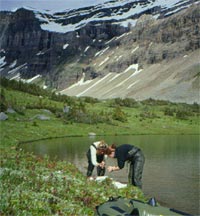 Alberta's WaterIntroductionPublications Climate Change Industrial Impacts Agricultural Impacts Urban Impacts Biodiversity Loss Definitions Links Site Map |
 |
|
 |
| Invertebrate sampling at Geraldine Lakes, Jasper National Park |
Fish with concentrations of MeHg sufficient to put human health at risk (0.5 ug/g) have been identified in remote lakes located far from point sources of contamination.
Methyl mercury (MeHg) is a vertebrate neurotoxin that can accumulate in organisms and magnify more than a million times in aquatic food chains, causing serious health problems in aquatic organisms and in humans that consume them. Mercury (Hg) has become pervasive even at remote locations, far from point sources, because gaseous Hg is efficiently transported in the atmosphere. This study used isolated lakes in the Canadian Rocky Mountains (Jasper, Banff, and Yoho National Parks and Mount Robson Provincial Park, at elevations of 760 to 2520 metres) to test hypotheses related to atmospheric deposition of Hg and bioaccumulation of MeHg.
 |
| Accumulation and magnification of MeHg in an aquatic food chain |
The general cycle of human-induced Hg contamination involves the release of stable, gaseous Hg to the atmosphere, primarily by the high-temperature combustion of coal and other fossil fuels. Hg can remain in the atmosphere for up to one year, travel long distances, and can be converted to the water-soluble ionic form, Hg2+, by photochemical reactions. Hg2+ is deposited to the landscape in precipitation or through dry deposition, and can therefore enter lakes directly or through runoff from within a catchment. It can be methylated to the most toxic form, MeHg (CH3Hg+), by sulphate-reducing bacteria in anaerobic environments such as lake sediments or wetlands. MeHg can then accumulate in organisms and magnify within food webs, causing organisms at high trophic levels (e.g., fishes) to contain the greatest quantities. Small amounts of MeHg have been found to affect embryo production and inhibit growth and reproductive development of fishes, as well as have toxic genetic effects. Fish with concentrations of MeHg sufficient to put human health at risk (0.5 ug/g) have been identified in remote lakes located far from point sources of contamination.



 Mercury deposition and accumulation in
Mercury deposition and accumulation in